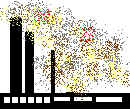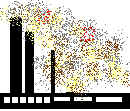


AIR POLLUTION - ACID RAIN



|
The term air pollution refers to the contamination of the
atmosphere caused by gaseous, liquid or solid wastes or
by-products which may endanger the health and welfare of
plants, animals and humans. Industrial countries generate billions of tons of pollutants every year. The major air pollutants are carbon monoxide (CO), sulphur dioxide (SO2), lead (Pb), nitrogen dioxide (NO2) and ozone (O3). Acid rain is a type of air pollution formed when sulphur and nitrogen oxide emissions combine with atmospheric moisture causing sulphuric and nitric acid, which may be carried long distances with the wind before coming down in the form of rain, snow or fog. Acid rain causes widespread environmental damage by eroding structures, injuring crops and forests by causing defoliation, and threatening and depleting life in freshwater lakes. The major pollutants in Lapland are the Enso Fine Papers in Kemi, StoraEnso in Kemijärvi and Outokumpu Steel in Tornio. The Kola Peninsula is one of the largest industrial zones in Europe. The effects of the massive industry are not yet visible in the forests on the Finnish side of the border. The damage so far is visible up to a distance of 50 km from the factories, air pollution has killed all the trees. Although sulphur deposition has decreased, it has not decreased enough. The most sensitive areas like Lapland are still in danger. An average of 0,4 grams of sulphur is still deposited per square metre every year in Finland, that's more than the forests of Lapland can take. |